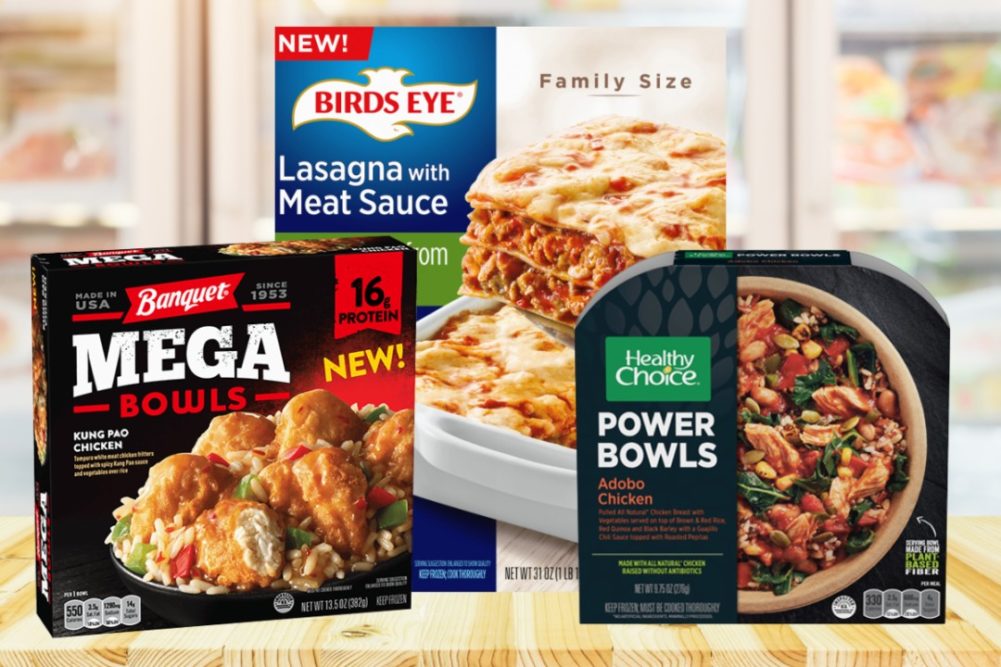CHICAGO – Elevated at-home demand for frozen foods, snacks and center store staples propelled Conagra Brands’ first quarter results. The company expects the higher level of demand to continue as fewer people eat out, more people are working from home and retailers seek to resupply depleted inventories.
“We see consumers experiencing and making lifestyle changes, driven by COVID-19, that suggests the arrival of a sustained shift in eating habits,” said Sean M. Connolly, president and chief executive officer, during an Oct. 1 conference call to discuss first-quarter results. “We also know from prior recessions that an economic downturn typically leads to a permanent increase in at-home eating, even when economic growth returns.”
Adding to Connolly’s optimism is how consumers are spending money they are saving from not eating out as often.
“Consumers are investing in their houses, their home gyms, their entertainment systems and their kitchens,” he said. “Data is showing that consumers are tackling more complex (food preparation) mediums. In other words, they’re upgrading their culinary skills. We don’t expect these upgrades to homes, at-home entertainment, kitchens and cooking skills to go away anytime soon.”
Net income for the first quarter ended Aug. 30 rose 89% to $329 million, equal to 67¢ per share on the common stock.
Sales rose 12% to $2.7 billion.
“Importantly, our higher-margin, nonpromoted volume contributed significantly to this growth,” Connolly said. “And not only did we grow at a great rate. We expanded our presence with consumers and gained share. We increased household penetration by 100 basis points and category share by 30 basis points.”
In the company’s Grocery & Snacks business unit, sales rose 16% to $1.1 billion. Operating profit surged 87% to $284 million.
“This segment benefited as consumers continue to purchase convenient, shelf-stable products to enhance their at-home eating experience,” said David S. Marberger, chief financial officer. “Segment growth in shipments this quarter exceeded growth in consumption as retailers began rebuilding inventories on brands such as Hunt’s, PAM, Duncan Hines and Vlasic.”
Refrigerated & Frozen business unit sales were $1.1 billion, an 18% increase over the previous year. Operating profit totaled $240 million, a 54% increase.
“This segment also experienced shipment growth greater than consumption growth in the quarter, primarily as a result of Birds Eye,” Marberger said.
Conagra’s Birds Eye business was limited during the fourth quarter of fiscal 2020 due to manufacturing capacity constraints.
“I'm pleased to report that during the first quarter, our Birds Eye plants are at full capacity and, as the quarter progressed, we qualified external manufacturers to supplement our capabilities,” Connolly said. “While our consumption in frozen vegetables grew 0.7% in the quarter, our shipments grew at a much faster rate as retailers started rebuilding inventories.
“Sitting here today, Birds Eye, which holds the No. 1 position in the category, and has over twice the category share compared to the closest branded competitor, is very well positioned as we enter the important holiday season.”
International business unit sales rose 7% to $219 million. Operating profit was $39 million, a 56% increase. The company’s Foodservice business unit saw its sales fall 22% to $195 million. Operating profit fell 20% to $25 million.
Foodservice volume fell 24% during the quarter due to lower restaurant traffic.
“This marks an improvement from last quarter as some restaurant traffic began to rebound,” Marberger said.
The company has continued to not issue full-year guidance, citing the uncertainty of the pandemic. But for the second quarter of fiscal 2021 management is guiding organic net sales growth of 6% to 8% and adjusted earnings per share in the range of 70¢ to 74¢.
“The dynamics surrounding COVID-19 continue to make forecasting with specificity a challenge,” Marberger said. “What we can share is that we anticipate a continuation of elevated retail demand throughout the second quarter.”
Connolly said total at-home meals have increased almost 6% in the three months since July.
“That’s almost 7 billion meals,” he said. “When you take a closer look at this growth by daypart, the increases in meals and dollars are skewing toward lunch and dinner. And as you know, Conagra is well-developed in both of those dayparts.
“Our portfolio over indexes in dinner and is almost at parity for lunch compared to the overall mix. And whether a consumer wants to cook from scratch to put those newly developed culinary skills to the test, or heat and eat, Conagra’s diverse portfolio can deliver a solution for every need in every daypart. So, we are very well positioned for when and how people are eating more at home.”


